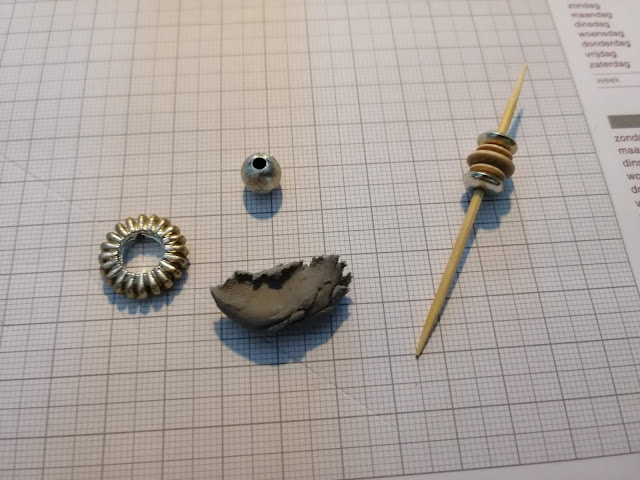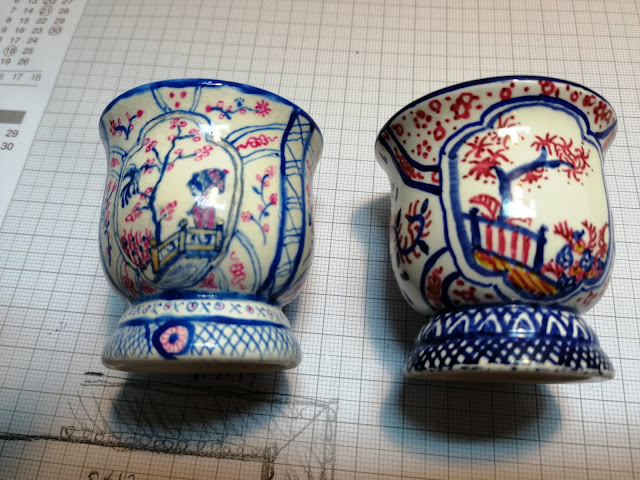Today I want to share with you a little miniature that I made. It is a miniature cup that pretends to be made with a Nautilus shell but is in fact just an ordinary snails shell. Found in a border in a local park. I found a few workshops in Dollshouse books and magazines that I have collected. So why not give it a try?
Opposed to that there was the collection of Artificialia. The excuisite objects that showed the craft and ingenuity of man. In the Netherlands the wealthy burghers liked to display their interests, knowledge and good taste by amassing similar collections but on a smaller scale.
You may know the renaissance phenomenon of the Wunderkammer. Collections of rarities put together by monarchs and nobility. Entire rooms filled with collections of colourful, exotic and rare specimen of shells, horns, et cetera. These were the so called Naturalia that showed the marvel of Gods creation.
For Huis ter Swinnendael I want to make two early baroque collectors cabinets. One for the Naturalia and one for the Artificialia. By 1806 these early 17th century collections have become rarities themselves. Many pieces are valuable and therefore are kept. But the later collections of paintings, porcelain and antiquities have by now become much more important for the family to show their refined taste.
But back to the cup. Many shells have very different shapes from a Nautilus. This snails shell is not a perfect match but goes a long way. First of all the snails shell was cleaned and painted with mother of pearl nailpolish. I did not give it a basecoat of white paint because I hope that the natural colours of the shell wil enliven the colour of the nailpolish from underneath.
Then I saw that the rim of the opening with this type of snail runs crooked. With the nautilus it does not. I took out the needlefiles and gently started to file down the edge to improve the Natilusness of the shell. After that I needed to repair the rim and other damaged area's with more nailpolish.
Now it was time for the stand or foot of the cup. I shoved some beads I have in my little collection onto a toothpick. I then filled the cavities with airdrying clay and cut off the excess toothpick on one side. I added some small stickers used for making and decorating cards. After the clay had fully dried I gave it a coat of bright red paint. Lastly I aplied a coat of gold paint. I want to gild the base but I have not yet come around to buying the stuff needed for gilding. So paint it is for now.
Finaly it is time to add the shell itself. Here I also applied some of these small stickers to simulate the addition of gold on the shell itself. I removed the remainder of the toothpick and glued the shell on the card and let it dry.
And there we have it, my first attempt to make a nautilus cup. I enjoyed making it. I hope you have enjoyed reading about it. I do want to try and make one with metal as a challenge for the near future. As you can see I have a few more snail shells to pollish.
Finaly it is time to add the shell itself. Here I also applied some of these small stickers to simulate the addition of gold on the shell itself. I removed the remainder of the toothpick and glued the shell on the card and let it dry.
And there we have it, my first attempt to make a nautilus cup. I enjoyed making it. I hope you have enjoyed reading about it. I do want to try and make one with metal as a challenge for the near future. As you can see I have a few more snail shells to pollish.
Those of you who have read my earlier posts may have noticed that in this picture there are a few new miniatures. The picture frame is a modern silverplate frame that I have painted gold. It wil be gilded eventually. The Bernini-esque bust was bought at Het Poppenhuis in Arnhem. A lovely visit of which I will show my new treasures in another post. And finaly the bronze statue of a Roman figure. It is a signet stamp used for wax seals. An antique I found on Etsy.
Well, thats it for now, be well and u til the next post!
Huibrecht

















